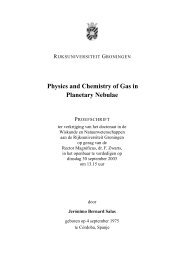TRACING ABUNDANCES IN GALAXIES WITH THE SPITZER ...
TRACING ABUNDANCES IN GALAXIES WITH THE SPITZER ...
TRACING ABUNDANCES IN GALAXIES WITH THE SPITZER ...
Create successful ePaper yourself
Turn your PDF publications into a flip-book with our unique Google optimized e-Paper software.
CHAPTER 1<br />
<strong>IN</strong>TRODUCTION<br />
On Earth, some snakes in the pit viper family have sacks on the sides of their<br />
heads that allow them to detect infrared light, or heat. This ability to “see” in<br />
the infrared allows the snakes to detect delectable rodents in dark underground<br />
tunnels where there is no optical light. Just as viewing objects on Earth in the<br />
infrared can uncover secrets hidden from optical light, viewing objects in space in<br />
the infrared allows astronomers to probe precious pieces of the cosmos unseen in<br />
the optical. For example, dust hinders optical studies because it absorbs optical<br />
light, but this same dust re-radiates the light in the infrared. Astronomers can<br />
identify the type of dust by looking at the features they produce in the infrared<br />
spectra (see §1.4).<br />
Infrared spectra also allow astronomers to determine the amounts of various<br />
elements (abundances) by measuring fluxes in infrared emission lines. Abundances<br />
from different locations in a galaxy give information about its formation and evo-<br />
lution. In the past, observations at optical wavelengths dominated abundance<br />
studies. However, studies at other wavelengths give new insights. This disserta-<br />
tion concentrates on what we can learn from infrared spectra of photoionization<br />
regions (specifically planetary nebulae and H II regions) in our Galaxy and M51<br />
(NGC 5194). First we derive abundances of the planetary nebula IC 2448 in the<br />
Disk of the Milky Way, finding that it has abundances of argon, neon, sulfur, and<br />
oxygen slightly lower than solar which implies that the cloud from which the pro-<br />
genitor star formed had a subsolar abundance. Then we derive abundances for<br />
eleven planetary nebulae in the Galactic Bulge, finding that these nebulae do not<br />
follow the trend of abundance versus galactocentric distance displayed by nebulae<br />
in the Disk, thus indicating the separate evolution of the Bulge and the Disk. Ad-<br />
1













